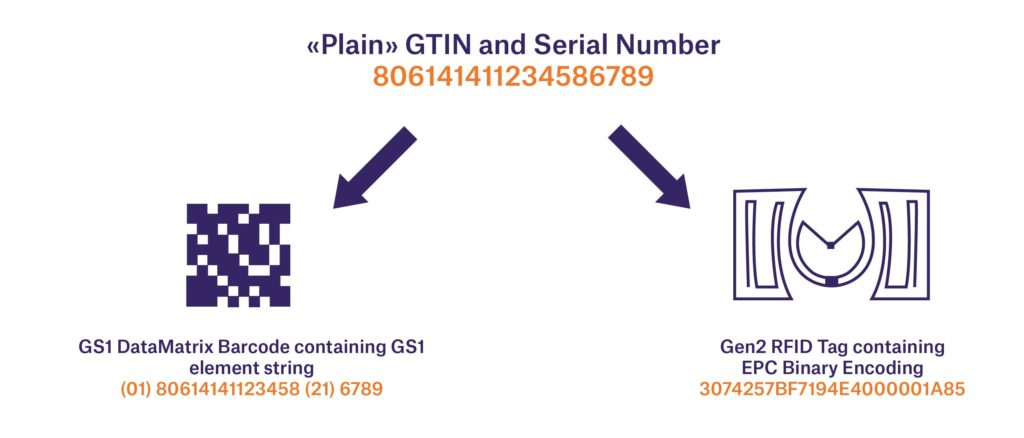
Though both barcodes and RFID have been around for 50 years (longer for barcodes), it was never really possible to combine the two efficiently, especially in the lab. That’s all changed recently, as it’s now possible to generate any tag or label—from cryogenic to chemical-resistant and autoclave—with an inlay for an RFID chip. This means that RFID labels can also be printed with barcodes. Though this provides several benefits, including adding an extra layer of security to samples, integrating both technologies into an efficient system may require troubleshooting. That’s why we decided to review some of the best practices when implementing a system that scans data from both barcodes and RFID, courtesy of GS1.
Data vs data carrier
First, it’s worth addressing a bit of terminology, so it’s easier to understand the principles behind GS1’s recommendations. GS1 is a neutral, not-for-profit, international organization that develops and maintains standards for barcodes and other identification methods. It’s also imperative to distinguish between the data (the information available regarding the item, such as sample name and date) and the data carrier (either RFID or one of the many types of barcodes). From the figure above, you’ll see a “plain” global trade item number (GTIN) and serial number. Depending on the technology used, these numbers can be outfitted with data carrier-specific encoding to be read appropriately.
Use a system that accepts data from any data carrier
Only applications and databases that accept the full range of data values, as defined by GS1 standards, should be used. This ensures that they can accept data no matter what data carrier is used (barcodes or RFID).
An example of a proper database includes a column for serial numbers (associated with a GTIN) that accepts between 1 and 20 alphanumeric characters. This database can register any serial number, regardless of the data carrier. In contrast, a database that only goes up to 12 numeric digits can register serial numbers read from a 96-bit RFID tag, but not from other types of RFID tags or barcodes because those carriers may contain a serial number that has alphanumeric characters and/or is longer than 12 characters.
Avoid assigning serial numbers that start with zero
Assigning zeros to the beginning of serial numbers is likely to cause trouble when encoding them in both barcodes and RFID tags. For instance, if a sample is assigned the serial number 004967 and a 96-bit RFID tag is used, the barcode will not be encodable as is; it will be encoded as 4967 instead, because 004967 is not encodable in this system. If this serial number is encoded with certain types of barcodes, the number might end up being 00004967 because an 8-digit serial number may be required to match the appropriate symbol size. Importantly, 004967 and 00004967 are entirely different serial numbers than 4967, so data is likely to be lost during the transition between each system.
Confine data carrier-specific representations to the lower levels of your workflow architecture
This tip is particularly important for large pharma companies who handle large sets of data from both “carrier-specific” and “application-level” interfaces, but the idea is the same for laboratories. What are “carrier-specific” and “application-level” interfaces? Carrier-specific refers to the interface where data is collected via barcode/RFID scanners and transmitted into a database. Application-level refers to interfaces that utilize the data directly, such as data analysis or management. Two of the most common application-level interfaces are the Enterprise Resource Planning (ERP) system and the Warehouse Management System (WMS), but laboratory information management systems (LIMS) would also be considered application-level.
GS1 recommends confining carrier-specific (i.e. RFID- or barcode-specific) data representations to carrier-specific interfaces and removing these when the data reaches application-level interfaces. This means that the system can more easily interoperate with all carriers used. If a carrier changes at some point (a new type of barcode is applied), then the system can quickly adapt, with less rework needed to integrate the change.
Use a printer and scanner that are capable of working with RFID and barcodes
This one isn’t a GS1-recommended solution; it’s just a general tip that will help optimize your system. Regardless of how your data is transmitted, it helps to centralize and share capabilities with the smallest footprint possible. This is especially important for laboratories and in manufacturing, where space is often an issue. In addition to printers and scanners, specialized software will likely be necessary to print any type of barcode, encode RFID chips, and integrate them into all other management systems (e.g. a LIMS or supply chain management system). Of particular interest is the coupling of RFID-capable printers to software like BarTender, which allows the simultaneous printing of visible information and encoding of RFID labels.
It’s becoming more common for laboratories, manufacturing facilities, and healthcare institutions to optimize their identification systems by combining the benefits of both barcode and RFID technology. It’s essential that, when choosing to implement both, personnel understand not just how to use the technology but how best to integrate the data into their workflow so that the system can be as cost-efficient and error-free as possible.
LabTAG by GA International is a leading manufacturer of high-performance specialty labels and a supplier of identification solutions used in research and medical labs as well as healthcare institutions.